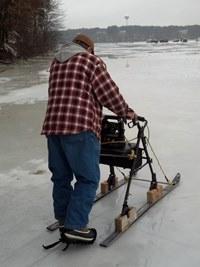Go Local to Learn Ice Conditions, Wisconsin DNR Wardens Advise
By Joanne M. Haas/Wisconsin DNR Bureau of Law Enforcement
from The Fishing Wire
While the new year stormed the nation with sub-zero temperatures, Department of Natural Resources conservation wardens remind all outdoor enthusiasts to go local to know the ice conditions before you go – and to be prepared if (gulp) you break through the ice.
Never give up! This Eau Claire County man created his ‘Rollator Walker’ so he could keep enjoying ice fishing. Warden Scott Thiede met the man on Lake Altoona in December. The man said he wasn’t about to let any physical issue stop him from his ice fishing!Warden April Dombrowski, who leads the crew of recreational safety wardens, says on this incredibly cold morning in the Badger State the DNR does not monitor ice conditions. She says it comes down to this: No ice is absolutely safe ice, and go local to get the latest info about your area lakes.
“It truly is up to the individual to learn the ice conditions. Talk to other ice fishers, snowmobilers, fishing clubs around the lake and bait store owners around the water body. These are the places locally most likely to have the most current information about the lakes and areas you want to use,” Dombrowski says. “Based on the varying conditions statewide, the DNR logistically cannot monitor ice conditions throughout Wisconsin. Similar to looking for information on how the fish are biting on a lake, it’s best to go with the local experts.”
And, like a lot of things in life, looks can be deceiving!
The ice conditions on any lake can vary from location to location. “You cannot determine the strength of an ice cover by a single factor – including how thick it is, or how long it’s been forming or the snow on top of it,” Dombrowski says. “Moving water from streams, rivers and springs can cause ice to form unevenly.”
If you do go on the ice
Dombrowski and the wardens offer these standard ice safety tips:
Dress warmly in layers.
Don’t go alone. Head out with friends or family. Take a cell phone if available. And, if you have a cell phone or not, make sure someone knows where you are and when you are expected to return.
Know before you go. Don’t travel in areas you are not familiar and don’t travel at night or during reduced visibility.
Avoid inlets, outlets or narrows that may have currents that can thin the ice.
Look for clear ice, which is generally stronger than ice with snow on it or bubbles in it.
Carry some basic safety gear: ice claws or picks, a cellphone in a waterproof bag or case, a life jacket and length of rope.
If you go through the ice
Dombrowski says all ice users should be prepared for the possibility of breaking through the ice. She recommends learning these tips:
Wear flotation garments that provide buoyancy – such as a float coat or a life vest over a regular jacket.
If you have those picks, use those and kick your feet as you crawl out of the water hole. Keep your body low to spread out your weight.
Don’t stand up right away once you’re out. Roll or crawl on your stomach until the majority of your body is on solid surface.
Head toward the direction you came from to get to the ice cover that supported your weight.
“Wisconsin’s winters can be a lot of fun with all the outdoor recreational opportunities,” Dombrowski says. “With just a bit of planning for safety’s sake, you’ll come home with some fun stories about enjoying the outdoors.”
And who doesn’t love a good story! Have fun and stay safe out there.
For more tips, the DNR also has information on its website about what to do should you fall through the ice and how to make ice claws:
http://dnr.wi.gov/topic/outdoorrecreation/activities/icesafety.html
